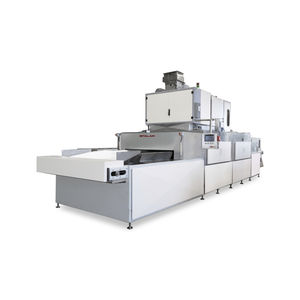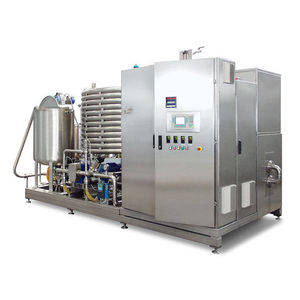

- Company
- Products
- Catalogs
- News & Trends
- Exhibitions
Pasteurizer for the food industry SANIPACK+in-linesteamhigh-temperature
Add to favorites
Compare this product
Characteristics
- Applications
- for the food industry
- Operating mode
- in-line
- Other characteristics
- steam, high-temperature, tunnel, radio frequency
Description
Traditional pasteurisation methods use hot air circulation, dripping hot water or direct steam injection into the treatment cabinet or tunnel for heating the packaged food. The temperature rise of the product is slow and non-uniform due to poor thermal conductivity of the packaging material, of the air or modified atmosphere contained in the package and within the food substrate itself. In order to reach a given temperature level in the coldest spot of the product a proportionally long heating time is required, affecting in particular the outside layers of food that are more exposed to heat. Consequently, the product loses its quality in terms of sensorial (colour, flavour, texture, etc.) and nutritional characteristics.
The drawbacks of conventional pasteurisation methods can be avoided thanks to the ability of radio frequency to rapidly generate heat volumetrically within the product.
Stalam is the first company worldwide to have developed industrial pasteurising equipment by radio frequency for packaged products such as bread loaves, fresh pasta, gnocchi, etc.
Rapid and uniform treatment
High reduction of the microbial load is achieved in a very short time, thanks to the fast and uniform heating process throughout the product and its packaging, which does not rely on (slow) heat transmission which is typical of conventional methods: the required microbial kill level is achieved in a few minutes rather than one hour or more
In-line process
Thanks to the high process speed, radio frequency pasteurisation can be carried out continuously, with significant logistic advantages in product handling and production scheduling
Catalogs
Food safety equipment
15 Pages
STALAM CATALOG - FOOD DIVISION
27 Pages
Related Searches
- Furnace
- Drying system
- Drying furnace
- In-line dryer
- Tunnel furnace
- Baking oven
- Air blast drying system
- Continuous furnace
- Drying system for the food industry
- Batch dewatering system
- Pasteurizer
- Drying system with belt conveyor
- Radiation dryer
- Pasteurizer for the food industry
- Dryer for the pharmaceutical industry
- Stainless steel drying system
- Horizontal drying system
- Drying system with temperature control
- Drying system with automatic controls
- Quick-drying dryer
*Prices are pre-tax. They exclude delivery charges and customs duties and do not include additional charges for installation or activation options. Prices are indicative only and may vary by country, with changes to the cost of raw materials and exchange rates.





